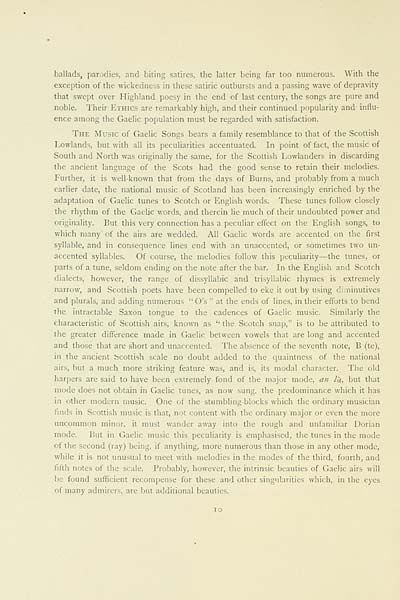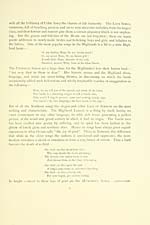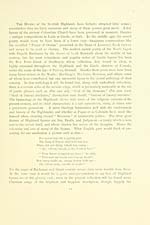Download files
Complete book:
Individual page:
Thumbnail gallery: Grid view | List view

ballads, parodies, and biting satires, the latter being far too numerous. With the
exception of the wickedness in these satiric outbursts and a passing wave of depravity
that swept over Highland poesy in the end of last century, the songs are pure and
noble. Their Ethics are remarkably high, and their continued popularity and influ-
ence among the Gaelic population must be regarded with satisfaction.
The Music of Gaelic Songs bears a family resemblance to that of the Scottish
Lowlands, but with all its peculiarities accentuated. In point of fact, the music of
South and North was originally the same, for the Scottish Lowlanders in discarding
the ancient language of the Scots had the good sense to retain their melodies.
Further, it is well-known that from the days of Burns, and probably from a much
earlier date, the national music of Scotland has been increasingly enriched by the
adaptation of Gaelic tunes to Scotch or English words. These tunes follow closely
the rhythm of the Gaelic words, and therein lie much of their undoubted power and
originality. But this very connection has a peculiar effect on the English songs, to
which many" of the airs are wedded. All Gaelic words are accented on the first
syllable, and in consequence lines end with an unaccented, or sometimes two un-
accented syllables. Of course, the melodies follow this peculiarity — the tunes, or
parts of a tune, seldom ending on the note after the bar. In- the English and Scotch
dialects, however, the range of dissyllabic and trisyllabic rhymes is extremely
narrow, and Scottish poets have been compelled to eke it out by using diminutives
and plurals, and adding numerous " O's " at the ends of lines, in their efforts to bend
the intractable Saxon tongue to the cadences of Gaelic music. Similarly the
characteristic of Scottish airs, known as " the Scotch snap," is to be attributed to
the greater difference made in Gaelic between vowels that are long and accented
and those that are short and unaccented. The absence of the seventh note, B (te),
in the ancient Scottish scale no doubt added to the quaintness of the national
airs, but a much more striking feature was, and is, its modal character. The old
harpers are said to have been extremely fond of the major mode, an Ik, but that
mode does not obtain in Gaelic tunes, as now sung, the predominance which it has
in other modern music. One of the stumbling-blocks which the ordinary musician
finds in Scottish music is that, not content with the ordinary major or even the more
uncommon minor, it must wander away into the rough and unfamiliar Dorian
mode. But in Gaelic music this peculiarity is emphasised, the tunes in the mode
of the second (ray) being, if anything, more numerous than those in any other mode,
while it is not unusual to meet with melodies in the modes of the third, fourth, and
fifth notes of the .scale. Probably, however, the intrinsic beauties of Gaelic airs will
lie found sufficient recompense for these and other singularities which, in the eyes
of many admirers, are but additional beauties.
exception of the wickedness in these satiric outbursts and a passing wave of depravity
that swept over Highland poesy in the end of last century, the songs are pure and
noble. Their Ethics are remarkably high, and their continued popularity and influ-
ence among the Gaelic population must be regarded with satisfaction.
The Music of Gaelic Songs bears a family resemblance to that of the Scottish
Lowlands, but with all its peculiarities accentuated. In point of fact, the music of
South and North was originally the same, for the Scottish Lowlanders in discarding
the ancient language of the Scots had the good sense to retain their melodies.
Further, it is well-known that from the days of Burns, and probably from a much
earlier date, the national music of Scotland has been increasingly enriched by the
adaptation of Gaelic tunes to Scotch or English words. These tunes follow closely
the rhythm of the Gaelic words, and therein lie much of their undoubted power and
originality. But this very connection has a peculiar effect on the English songs, to
which many" of the airs are wedded. All Gaelic words are accented on the first
syllable, and in consequence lines end with an unaccented, or sometimes two un-
accented syllables. Of course, the melodies follow this peculiarity — the tunes, or
parts of a tune, seldom ending on the note after the bar. In- the English and Scotch
dialects, however, the range of dissyllabic and trisyllabic rhymes is extremely
narrow, and Scottish poets have been compelled to eke it out by using diminutives
and plurals, and adding numerous " O's " at the ends of lines, in their efforts to bend
the intractable Saxon tongue to the cadences of Gaelic music. Similarly the
characteristic of Scottish airs, known as " the Scotch snap," is to be attributed to
the greater difference made in Gaelic between vowels that are long and accented
and those that are short and unaccented. The absence of the seventh note, B (te),
in the ancient Scottish scale no doubt added to the quaintness of the national
airs, but a much more striking feature was, and is, its modal character. The old
harpers are said to have been extremely fond of the major mode, an Ik, but that
mode does not obtain in Gaelic tunes, as now sung, the predominance which it has
in other modern music. One of the stumbling-blocks which the ordinary musician
finds in Scottish music is that, not content with the ordinary major or even the more
uncommon minor, it must wander away into the rough and unfamiliar Dorian
mode. But in Gaelic music this peculiarity is emphasised, the tunes in the mode
of the second (ray) being, if anything, more numerous than those in any other mode,
while it is not unusual to meet with melodies in the modes of the third, fourth, and
fifth notes of the .scale. Probably, however, the intrinsic beauties of Gaelic airs will
lie found sufficient recompense for these and other singularities which, in the eyes
of many admirers, are but additional beauties.
Set display mode to: Large image | Transcription
Images and transcriptions on this page, including medium image downloads, may be used under the Creative Commons Attribution 4.0 International Licence unless otherwise stated. ![]()
| Early Gaelic Book Collections > Blair Collection > Songs and hymns of the Scottish Highlands > (14) |
|---|
| Permanent URL | https://digital.nls.uk/75799552 |
|---|
| Description | A selection of books from a collection of more than 500 titles, mostly on religious and literary topics. Also includes some material dealing with other Celtic languages and societies. Collection created towards the end of the 19th century by Lady Evelyn Stewart Murray. |
|---|
| Description | Selected items from five 'Special and Named Printed Collections'. Includes books in Gaelic and other Celtic languages, works about the Gaels, their languages, literature, culture and history. |
|---|

